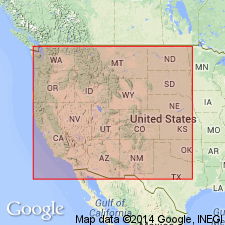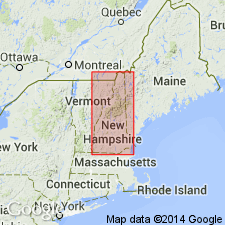
- Usage in publication:
-
- Umbagog Granodiorite*
- Modifications:
-
- Geochronologic dating
- AAPG geologic province:
-
- New England province
Summary:
Pg. 24, geologic time scale (inside front cover). Umbagog Granodiorite. Sample from foliated border zone in Umbagog Granodiorite, at Pine Point, Umbagog Lake, Lat. 44 deg. 47 min. 35 sec. N., Long. 71 deg. 02 min. 21 sec. W., Errol quadrangle, Coos County, New Hampshire, yielded a Pb-alpha age of 360 +/-40 Ma (zircon). This reconnaissance age, as reported by Green (GSA Spec. Paper 77, 1964), indicates a Devonian age for the pluton. Ages calculated using decay constants of Steiger and Jager, 1977 (Earth Planet. Sci. Letters, v. 36, p. 359-362).
Source: Publication.

- Usage in publication:
-
- Umbagog Granodiorite*
- Modifications:
-
- Geochronologic dating
- Age modified
- AAPG geologic province:
-
- New England province
Summary:
Shown on 1:500,000-scale derivative map of plutons and sample localities for isotope dating. Age of 384 +/-6 Ma [Middle Devonian by time scale of Palmer, 1983] by U/Pb methods is from Aleinikoff and Moench (1987; Geological Society of America, Abstracts with Programs, v. 19, p. 1).
Source: GNU records (USGS DDS-6; Reston GNULEX).
For more information, please contact Nancy Stamm, Geologic Names Committee Secretary.
Asterisk (*) indicates published by U.S. Geological Survey authors.
"No current usage" (†) implies that a name has been abandoned or has fallen into disuse. Former usage and, if known, replacement name given in parentheses ( ).
Slash (/) indicates name conflicts with nomenclatural guidelines (CSN, 1933; ACSN, 1961, 1970; NACSN, 1983, 2005, 2021). May be explained within brackets ([ ]).

